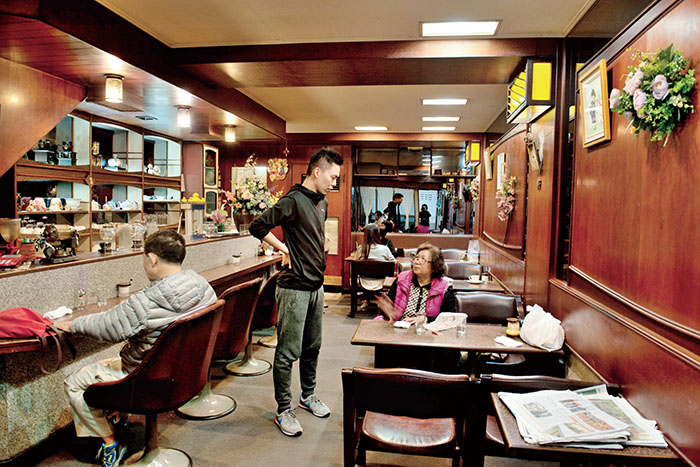Savor the Beauty of Kaohsiung through its Coffee and Art/品咖啡、饗藝文,高雄多美好
Savor the Beauty of Kaohsiung through its Coffee and Art
◎Written by Tomoaki Kuramoto ◎English translation: Peng Hsin-yi
◎Photo by Siao Meng-cyu
My Japanese friends always ask me if I drink tea every day in Taiwan. Indeed, it is an inevitable stereotype, when almost every Japanese visitor coming to Taiwan is shopping for souvenir high altitude mountain tea and pineapple cakes. However, they are always surprised to find out that I usually drink coffee here.
Taiwan's coffee shops are representative of its modern culture. They often host various activities, including, live bands, movie nights, author's roundtables and book signings etc. and with the various amenities they offer, they are at the very heart of Taiwan's pop culture. It is easy for guests to feel right at home here and to relax in their own creative world.
Traditionally, Kaohsiung was known as a "cultural desert". However, now I think that only people who are oblivious of Kaohsiung's coffee culture would make that assumption. Compared with Taipei and Tainan, it may appear that the number of coffee shops in Kaohsiung is far inferior, but Kaohsiung's coffee shop comes first in style and innovation.
Mr. Li Geng-hao, owner of Ruh Cafe on Sihwei 3rd Road feels: Coffee shops in Taipei may be new and pristine, but they are just like the people they serve, way too busy! In Tainan, many of the coffee shops are converted from old houses which date back to the Japanese colonial days, thus presenting a unique atmosphere. However, many of Tainan's coffee shops are located in narrow alleyways, making it feel like they are practically on top of each other. Coffee shops in Kaohsiung can be regarded as something in between the two, making it just right!
 Having been open for only a year, Ruh Cafe is a fairly new coffee shop. The venue is an old concrete building, which after some renovation it seamlessly blends in with the architecture of the neighborhood. Regular customers love to sit at the bar, sipping their brewed to order coffee. Japanese tatami straw floor mats are located on the second floor, allowing customers to stretch out, just as they would do if they were at home.
Having been open for only a year, Ruh Cafe is a fairly new coffee shop. The venue is an old concrete building, which after some renovation it seamlessly blends in with the architecture of the neighborhood. Regular customers love to sit at the bar, sipping their brewed to order coffee. Japanese tatami straw floor mats are located on the second floor, allowing customers to stretch out, just as they would do if they were at home.
I asked Mr. Li about other recommend coffee shops. He momentarily retreated into the kitchen to consult his staff and when he returned, he had a paper full of names and addresses of other coffee shops around Kaohsiung. Most of them were located in historical and scenic areas located between Yanchengpu and the Cultural Center. He then deliberated, "If you are looking to travel back in time, Hifumitei Ryotei would be my first choice". I heartily agreed. Hamasen is housed in an old Japanese building, which reflects the Japanese Showa period. Japanese oldies are played over their sound system, similar to the old-fashioned restaurants my grandfather took me to as a child. In the French novel (In Search of Lost Time), Marcel Proust says "Food and the atmosphere in this coffee shop always took me back to a certain time and place in my childhood." Perhaps, Taiwanese customers can picture their grandparents frequenting these types of places when they were kimono-clad youths.
TaKaoBooks is a bookstore, a coffee shop and a hub for art exhibitions that is located in a renovated old building near Kaohsiung's Cultural Center. On the ground floor there is a bookstore which frequently hosts literary and arts events. The coffee shop is located on the second floor, with the third floor and basement being used for seminars, performances and classes. Many celebrated writers and movie directors frequent this place and host forums with Taiwanese youth who are passionate about the arts and literature.
Other coffee shops included on Mr. Li Geng-hao's list were Days Cafe & brunch which serves really good food and Cafe de Coeur, famous for its coffee aroma. Another popular coffee shop and bookstore is 4 SCREEN PRINTING. However, they don't have regular business hours. The last cafe he recommended was PIEFFEE as they are famous for their delicious quiches.
Mr. Li then shared some advice to those that may be thinking of opening a coffee shop. Firstly, keep it simple. Make sure customers find the space soothing. It isn't a huge money making business, so you must provide a good service and finally, make sure it has a unique personality. There are many unique coffee shops in Kaohsiung, with their tastes and personalities embodying the very heart of this unique and diverse city.
品咖啡、饗藝文,高雄多美好
◎文/倉本知明 ◎攝影/蕭孟曲
「你竟然在台灣待這麼久,那你每天都在喝台灣茶吧?」日本朋友經常問起類似的問題。的確,彷彿是一種義務一般,來台之際大量購買高山茶(與鳳梨酥)的日本人而言,這種刻板印象是不可避免的。我只回答說:「說實話,我在這裡喝咖啡的機會比較多。」台灣的咖啡店能夠代表現代台灣文化,毫無不為過吧!對外國人來說,台灣的咖啡店是提供驚奇與歡喜的神祕小窩。在摩登或閑靜的小屋裡,不定期舉辦樂團演唱會、放映電影、作家演講及簽名會等,台灣的咖啡店顯然是流行文化的發源地。聚在此地的客人也可以沉浸於自己的世界,輕鬆得像過著居家一樣。但如果在日本的咖啡店久坐可是罪該萬死的行為,要是你在日本的咖啡店打開筆電,隔著電腦螢幕可能將會感受到老闆滿臉怨氣的神情囉!
高雄咖啡店兼具台北、台南好處
也就是說,我們把咖啡店的種類及各種活動可以看成在地文化隆盛的節拍器。長久以來,高雄被稱為文化沙漠,我卻認為不知高雄咖啡文化的外行人才會這麼稱呼我們的港都吧!當然,與台北首都或台南古都相比,高雄的咖啡店數肯定處於劣勢,但高雄的咖啡店具有兩座城市所缺乏的特質。位於面對四維三路的路人咖啡老闆李耕豪說:「台北的咖啡店雖然又新又美,但是跟他們的生活一樣,過於忙碌啦!台南的咖啡店改建日據時代留下的老房屋,相當有品味,而都集中於窄小的小巷裡。相比之下,高雄的咖啡店兼具他們具有的好處呀!」
也可以說,兼具寬闊而悠閒的高雄咖啡店算是置於台北與台南的中間地位。路人咖啡是去年才開的新店鋪,改建混凝土的老建築,相當融入附近住宅區,吧檯的熟客喝著手工咖啡,樂於閒聊。上到二樓,鋪滿日式榻榻米,客人能夠舒展四肢,輕鬆得像居家。「你有其他推薦的咖啡店嗎?」聽到我的提問,老闆回到廚房,問其他員工。眨眼間,他手上的紙條寫滿了高雄各地的咖啡店。被他寫下的咖啡店集中於鹽埕埔至文化中心的歷史景觀區。
「說到歷史,還是一二三亭吧。」我也首肯,來玩哈瑪星的人應該都有聽過她的芳名吧?改建自日式老房屋,充滿昭和時代的復古味。傾聽播放的日文老歌,我不禁想起小時候外公常帶我去的懷舊餐廳。就像《追憶似水年華》一樣,他們提供的食物與空間使我想起童年時代的某個場景。也許,台灣客人也能從中想像身穿和服的阿公阿媽的青春年代吧。
咖啡店就是居民的美好綠洲
與其相比,位於文化中心附近的三餘書店經常都辦文藝活動。改建舊房的三餘書店一樓就是獨立書店,二樓則是咖啡店,三樓與地下室是講座表演及課程空間。著名的作家及電影導演定期拜訪此店,與港都文青進行交流。三餘書店則是高雄文藝文化的集聚地!「日日咖啡的食物品味頗好,要是你想要享受咖啡香味該去真心豆行。此外,不定期開店的絹窩是一間神秘的書店咖啡店。元啡驢派的鹹派品味超好的。」路人老闆滔滔不絕地說下高雄各地的咖啡店名及他們的特色。
「你說經營咖啡店最重要的事情?越簡單越好啊。重點是給客人一個輕鬆的空間。當然,因為我們缺錢,什麼都要自己做的。」他笑著說。就像每個都市各有他的特色一樣,港都的咖啡店也有他的獨特的品味與味道。因此可以得知,咖啡店就是我們文化沙漠居民的美好綠洲哪!